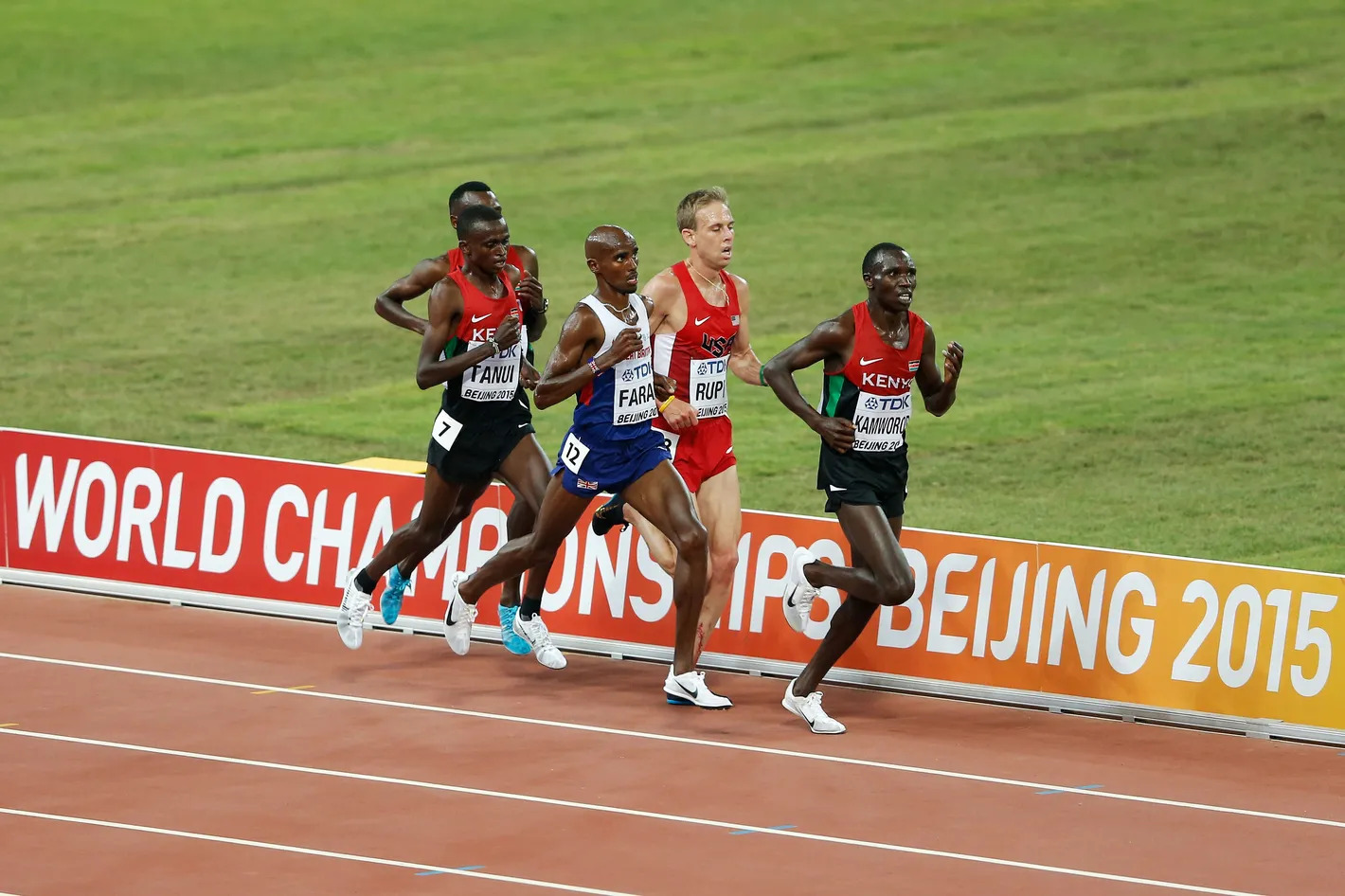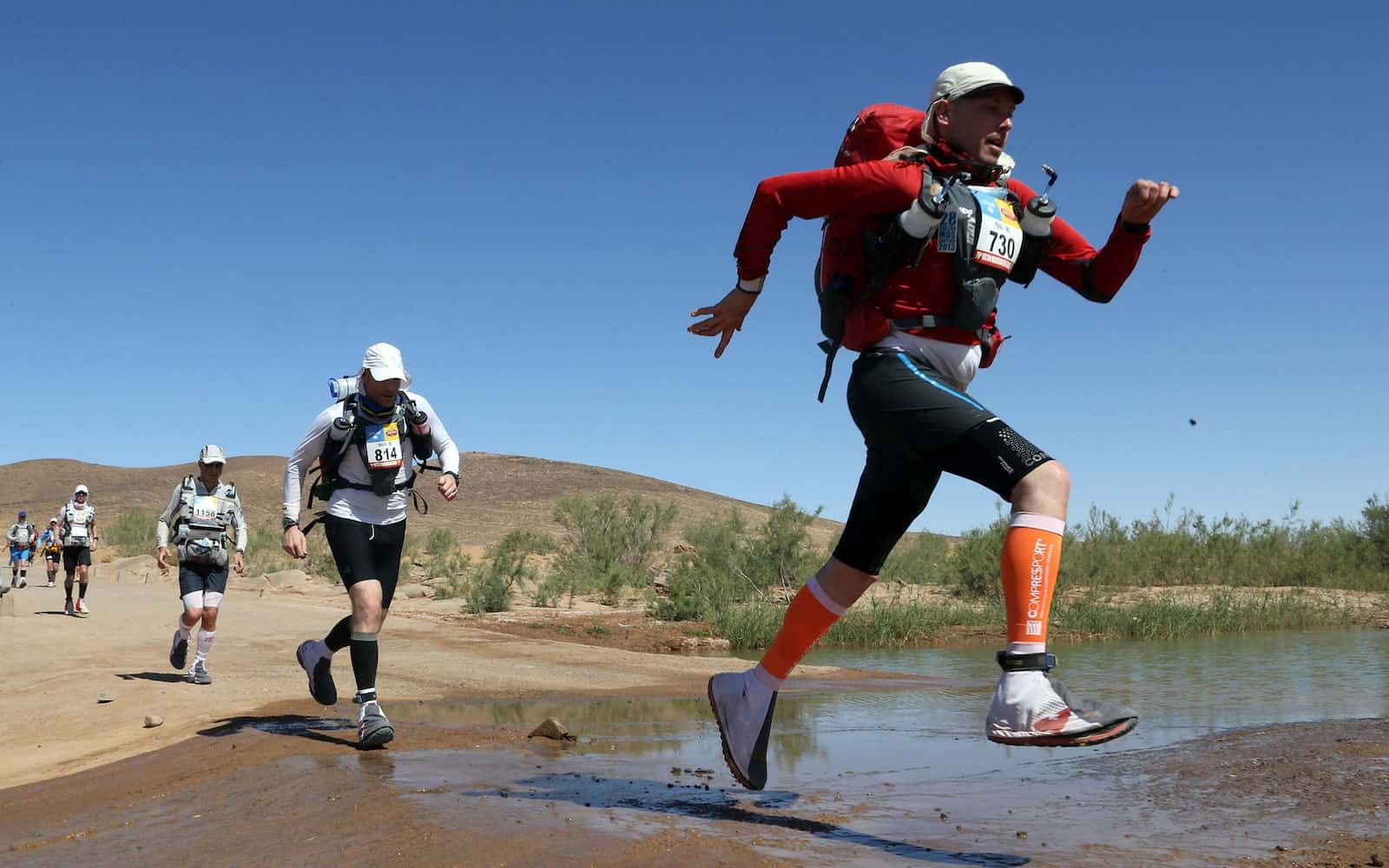

Featured
What Sport Requires The Most Endurance
Modified: January 2, 2024
Discover the sport that demands the ultimate endurance. Explore our featured article to uncover what sport requires the most physical and mental stamina.
Introduction
Sports that require high levels of endurance push athletes to their limits, testing their physical and mental strength. These sports demand not only physical fitness but also mental fortitude, as competitors push through fatigue and discomfort to achieve their goals. Whether it’s pounding the pavement in long-distance running or battling the elements in rowing, these sports require a unique combination of stamina, discipline, and perseverance.
In this article, we will explore some of the sports that demand the most endurance from athletes. From individual sports like long-distance running and cycling to team sports like soccer and basketball, we will delve into the physical and mental demands of each discipline.
Endurance sports are not for the faint-hearted. They require dedication, discipline, and a relentless pursuit of physical and mental fitness. Athletes must develop the ability to keep pushing themselves beyond their comfort zones, staying focused even in the face of fatigue and adversity.
By understanding the challenges and demands of these sports, we can gain a greater appreciation for the dedication and determination required to excel in them. Let’s dive into the world of endurance sports and discover what it takes to compete at the highest level.
Long-Distance Running
Long-distance running is a sport that tests both physical endurance and mental resilience. Whether it’s a marathon, an ultra-marathon, or a cross-country race, long-distance runners push their bodies to the limit, covering substantial distances over extended periods of time.
What makes long-distance running particularly demanding is the consistent pace and the relentless pounding of the pavement. Endurance runners need to have exceptional cardiovascular fitness, as their heart and lungs must work efficiently to supply oxygen to their muscles throughout the race.
Aside from the physical demands, long-distance running requires mental strength. Runners often experience moments of doubt and fatigue, but they push through to overcome the mental barriers that arise during a race. The ability to maintain focus and push oneself when the body is begging to stop is what separates the elite long-distance runners from the rest.
In addition to physical and mental endurance, long-distance runners must also possess good running form and efficient technique to ensure they can sustain their pace over long distances. Proper training and conditioning play a critical role in preventing injuries and maximizing performance.
Some of the world’s most famous long-distance running events include the Boston Marathon, the New York City Marathon, and the Olympic marathon. These races attract elite runners from around the world who compete for prestige and accolades.
Participating in long-distance running can be a transformative experience, as it challenges individuals to break through their perceived limitations and discover their inner strength. The discipline, dedication, and perseverance required to succeed in long-distance running are qualities that can extend beyond the racecourse and positively impact other areas of life.
Cycling
Cycling is another sport that demands high levels of endurance. Whether it’s road cycling, mountain biking, or track cycling, cyclists must possess incredible stamina to endure long rides or grueling races.
Road cycling, in particular, showcases the endurance aspect of the sport. Professional road cyclists compete in multi-stage races like the Tour de France, where they cover hundreds of kilometers each day for several consecutive days. These races not only require physical endurance but also strategic thinking and tactical decision-making.
Cyclists train their bodies to efficiently generate and sustain power while pedaling for long periods. They need to develop strong cardiovascular fitness to efficiently transport oxygen to their muscles, enabling them to maintain a consistent high-intensity effort.
One of the unique challenges in cycling is the ability to combat wind resistance and navigate various terrains. Uphill climbs test both the physical and mental strength of cyclists, while downhill descents demand focus and control.
Endurance in cycling is not just about the physical aspect; it also involves mental resilience. Cyclists need to push through pain and discomfort, especially during challenging climbs or when facing adverse weather conditions. The ability to overcome these obstacles and stay focused on the race objectives is crucial in achieving success in the sport.
Participating in long-distance cycling events or races can provide a sense of adventure and exploration, allowing cyclists to discover new landscapes and challenge themselves both physically and mentally. It’s a sport that promotes a strong sense of community and camaraderie among riders.
From scenic road routes to thrilling mountain trails, cycling offers athletes the opportunity to push their limits and explore the world on two wheels. The dedication and commitment required to excel in cycling have made it a highly respected endurance sport that captivates both participants and spectators alike.
Swimming
Swimming is a sport that demands exceptional endurance and efficiency in the water. Whether it’s pool swimming or open-water swimming, athletes in this sport must possess both physical and mental stamina to excel.
Swimmers rely on the coordination of their entire body, utilizing their arms, legs, and core to propel themselves through the water. The repetitive nature of swimming requires sustained effort over long distances, making cardiovascular endurance critical to success.
Endurance in swimming is not just about the ability to swim long distances but also about maintaining a consistent pace throughout the race. Swimmers need to develop efficient swimming techniques to minimize resistance and drag, allowing them to move more effortlessly through the water.
Another aspect of swimming endurance is the ability to handle different conditions in open-water swimming. Competing in natural bodies of water presents its own challenges, such as dealing with currents, waves, and unpredictable weather.
Mental strength is also essential in swimming, as it can be a solitary sport with long hours spent in the pool or open water. Swimmers must stay focused and motivated, pushing through fatigue and monotony to achieve their goals.
Swimming offers a low-impact workout that provides numerous benefits for overall fitness and cardiovascular health. It engages almost all the major muscle groups, improving strength, endurance, and flexibility.
From competitive swimming events to long-distance open-water crossings, swimming offers athletes the opportunity to test their limits and explore their capabilities in the water. It is a sport that requires dedication, perseverance, and a love for the water.
Swimming endurance is not only valued among competitive swimmers but also among recreational swimmers who enjoy the challenge of pushing themselves to swim longer distances or complete open-water swims.
Whether it’s for personal achievement or competitive aspirations, swimming is a fantastic endurance sport that allows athletes to immerse themselves in a world of physical and mental challenges while enjoying the beauty and serenity of the water.
Triathlon
Triathlon is a multi-sport endurance event that combines swimming, cycling, and running into one grueling race. Athletes who participate in triathlons must possess exceptional endurance, as they tackle three different disciplines back-to-back.
The swim portion of a triathlon requires not only physical fitness but also mental fortitude. Open-water swimming can present challenges such as currents, waves, and limited visibility, making it essential for triathletes to be prepared for any conditions they may encounter.
Following the swim, competitors transition to the cycling portion of the race. Cycling in a triathlon demands not only the ability to generate power on the bike but also the mental skill to pace oneself and conserve energy for the subsequent run.
Finally, triathletes finish the race with the run, which is the ultimate test of endurance. After swimming and cycling, runners must dig deep to find the physical and mental strength to maintain a steady pace and finish strong.
A key component of triathlon endurance is the smooth transition between each discipline. Athletes must not only switch from swimming to cycling to running efficiently but also manage their energy levels and mental focus during the transitions to ensure a seamless race.
Training for a triathlon involves balancing the demands of three different sports, incorporating swim workouts, long bike rides, and running sessions, as well as practicing transitions between disciplines. Triathletes also need to develop mental resilience to push through fatigue and stay focused during the race.
Participating in a triathlon is not only a test of physical endurance but also a unique blend of strategies and skills. It requires careful planning, efficient use of energy, and mental resilience to overcome the physical and mental challenges that arise throughout the race.
Triathlons offer athletes a unique and rewarding experience, as they push themselves to new limits and embrace the thrill of conquering three different sports in one event. The endurance and perseverance required to complete a triathlon make it a highly respected and inspiring sport.
Cross-Country Skiing
Cross-country skiing is a demanding winter sport that requires both physical fitness and technical skill. It combines endurance, strength, and balance as athletes glide across snow-covered terrain using specialized skis and poles.
Endurance is a key component of cross-country skiing, as athletes must maintain a steady pace for long distances. This sport incorporates both the upper and lower body, with skiers relying on their cardiovascular fitness to maintain an efficient stride throughout the race.
Unlike downhill skiing, cross-country skiing involves continuous movement, making it a full-body workout. Skiers engage their core muscles for balance and stability while using their arms and legs to propel themselves forward.
The challenging aspect of cross-country skiing is the variable terrain and weather conditions. Athletes must adapt their technique to uphill ascents, downhill descents, and flat sections, all while navigating through snow, icy patches, and changing landscapes.
Mental endurance is also crucial in cross-country skiing, as skiers must push through muscle fatigue and overcome the monotony of long-distance races. Staying focused and maintaining a positive mindset can be the key to staying motivated and achieving success on the track.
Cross-country skiing is a sport that offers a unique experience of being in nature and enjoying the winter scenery. It allows athletes to explore vast snowy landscapes, gliding through forests, valleys, and mountains, often in picturesque locations.
Training for cross-country skiing involves a combination of endurance exercises, strength training, and technique work. Skiers need to build their aerobic capacity through long-distance skiing sessions, as well as develop power, speed, and balance to navigate various terrains.
Participating in cross-country skiing not only provides an excellent cardio workout but also cultivates a sense of adventure and appreciation for the winter environment. It is a sport that requires dedication, perseverance, and a love for the snowy outdoors.
Whether competing in races or embarking on recreational ski trips, cross-country skiing offers athletes a challenging and rewarding experience that combines physical endurance, technical proficiency, and a deep connection to nature.
Rowing
Rowing is a sport that demands not only physical endurance but also precise technique and teamwork. Whether it’s rowing in a single scull or as part of a crew in a larger boat, rowers must possess exceptional strength, stamina, and mental resilience.
Rowing requires sustained effort over long distances, with rowers propelling the boat through the water using oars. The repetitive nature of rowing places high demands on the cardiovascular system, making endurance a critical component of success in the sport.
In addition to physical stamina, rowing also emphasizes technique. Proper rowing technique involves coordinated movements of the arms, legs, and core to generate power and maintain a smooth and efficient stroke. The efficiency and precision of the rowing stroke play a crucial role in maximizing speed and conserving energy.
Furthermore, rowing is a team sport that requires coordination and synchronization among the crew members. Each rower must row in unison with their teammates, working together to maintain the boat’s rhythm and achieve optimal performance.
Mental endurance is essential in rowing, as rowers often face prolonged periods of intense physical exertion. The ability to stay mentally focused and push through fatigue and discomfort is crucial in achieving success during races or long rows.
Rowing offers a unique experience of being on the water, whether it’s rowing on calm lakes or battling the currents in rivers or the open sea. This connection to nature adds an element of serenity and tranquility to the physically demanding aspects of the sport.
Training for rowing involves a combination of endurance workouts, strength training, and technical drills. Rowers must build their cardiovascular fitness through rowing sessions and complement their training with exercises to strengthen the rowing muscles and improve overall fitness.
Participating in rowing cultivates a sense of camaraderie and teamwork among rowers, as they strive for success together. It teaches valuable life skills such as discipline, perseverance, and the ability to work collaboratively towards a common goal.
Rowing is not only a highly competitive sport but also a recreational activity enjoyed by individuals of all ages and fitness levels. It offers a full-body workout, improves cardiovascular health, and allows participants to appreciate the beauty of being on the water.
Whether rowing for competition or for leisure, this endurance sport provides a unique blend of physicality, technique, and teamwork that makes it an engaging and gratifying pursuit.
Soccer
Soccer, also known as football in many parts of the world, is a team sport that demands endurance, agility, and skill. Players must possess both physical fitness and mental acuity to excel in this fast-paced and dynamic game.
Endurance is a crucial aspect of soccer as players continuously run for extended periods. The game involves a combination of short bursts of intense activity and longer periods of sustained effort, demanding cardiovascular fitness to keep up with the pace of play.
Soccer players engage in quick sprints, sharp changes in direction, and constant movement on the field. They need to have good stamina to perform at a high level throughout the duration of the match.
In addition to physical endurance, soccer also requires mental endurance. Players must stay focused and alert for the entire duration of the game, making split-second decisions, anticipating opponents’ moves, and constantly adjusting their positions on the field.
Endurance in soccer is not just about running; it’s also about the ability to withstand physical challenges. Players often face tough tackles, collisions, and demanding physical contact, requiring mental strength and resilience to keep going despite the physical demands of the game.
Soccer is a sport that incorporates both individual skills and team dynamics. Players must combine their physical abilities with technical and tactical proficiency, working together to create scoring opportunities and defend against their opponents.
Training for soccer involves a combination of aerobic conditioning, strength training, and skill development. Players focus on improving their speed, agility, and endurance through drills, fitness exercises, and match simulations.
Participating in soccer fosters not only physical fitness but also promotes teamwork, communication, and camaraderie among players. The dynamics of working together as a team and pursuing a common goal add an element of unity and cooperation to the sport.
From grassroots leagues to professional competitions, soccer captivates fans worldwide with its thrilling displays of endurance, skillful play, and passionate performances. It is a sport that brings people together, evoking emotions and showcasing the beauty of the game.
Whether playing on well-manicured stadiums or makeshift fields in local communities, the endurance required in soccer contributes to the sport’s universal appeal and enduring popularity.
Basketball
Basketball is a fast-paced team sport that requires a combination of skill, athleticism, and endurance. Players who excel in basketball must possess both physical and mental stamina to perform at a high level throughout the game.
Endurance is a critical aspect of basketball as players constantly move on the court, running, jumping, and changing directions. The game involves both short bursts of energy and longer periods of sustained effort, making cardiovascular fitness essential to keep up with the pace of play.
Basketball players must have the endurance to maintain a high level of performance throughout the duration of the game, playing both offense and defense. They need to possess the stamina to defend opponents, execute offensive plays, and make fast decisions under pressure.
In addition to cardiovascular endurance, basketball also requires mental endurance. Players must stay focused and mentally sharp in the face of physicality, intense competition, and the demands of the game. They need to make split-second decisions, read the movements of opponents, and execute precise passes and shots with accuracy.
Endurance in basketball is not just about physical exertion; it’s also about the ability to handle the ups and downs of the game. Players must maintain their mental fortitude and composure, pushing through fatigue, and staying motivated despite the challenges they may encounter during a match.
Training for basketball involves a combination of aerobic conditioning, strength training, and skill development. Players work on building their endurance through various drills, scrimmages, and game-like simulations. They also focus on improving their vertical leap, agility, and speed to enhance their overall performance on the court.
Participating in basketball not only promotes physical fitness but also fosters teamwork, communication, and camaraderie among players. The collaborative nature of the sport encourages players to develop trust, make quick decisions, and work together towards achieving a common goal.
Basketball has a global following and captivates fans with its high-flying dunks, precise shooting, and strategic plays. The endurance required in basketball contributes to the sport’s excitement, showcasing the incredible physical and mental capabilities of its athletes.
Whether playing in recreational leagues or competing at the professional level, basketball provides a platform for players to display their endurance, skill, and teamwork. It is a sport that resonates with people of all ages and brings communities together.
The enduring popularity of basketball is a testament to its universal appeal, as players and fans continue to be captivated by its fast-paced action, skillful displays, and the relentless endurance showcased on the court.
Conclusion
Endurance is a fundamental aspect of many sports, pushing athletes to their limits and showcasing the importance of physical and mental stamina. The sports we have explored – long-distance running, cycling, swimming, triathlon, cross-country skiing, rowing, soccer, and basketball – all require exceptional endurance, each in their own unique way.
From the relentless miles logged in long-distance running to the intense bursts of energy in basketball, these sports demand dedication, discipline, and a relentless pursuit of physical and mental fitness. Athletes in these sports must push themselves beyond their comfort zones, staying focused even in the face of fatigue, physical challenges, and mental barriers.
Endurance sports offer a transformative experience to athletes, allowing them to break through perceived limitations and discover their inner strength. These sports teach us important life lessons such as discipline, perseverance, and the rewards that come from hard work and dedication.
Whether it’s the serenity of swimming in open water, gliding through winter landscapes in cross-country skiing, or the thrill of competing in a team sport like soccer or basketball, endurance sports provide unique challenges and opportunities for personal growth.
Training for endurance sports involves a combination of physical conditioning and mental preparation. Athletes must also pay attention to recovery, nutrition, and injury prevention to ensure they can continue to perform at their best.
While each sport showcased in this article has its own specific demands, they all have one thing in common: the ability to test and develop an individual’s endurance. From the individual efforts of long-distance runners and swimmers to the teamwork required in rowing and soccer, the pursuit of endurance brings athletes together and leaves a lasting impact on their lives.
So, whether you’re an athlete seeking to challenge yourself or simply an admirer of endurance sports, take a moment to appreciate the dedication, determination, and resilience of those who participate in these incredible pursuits.









